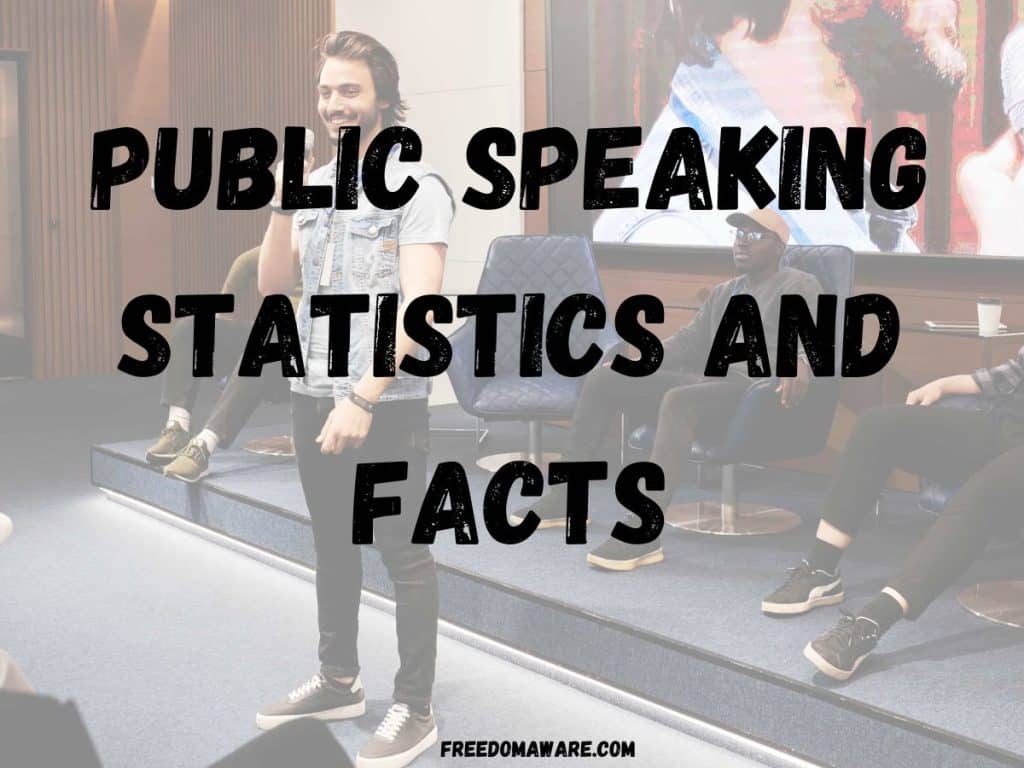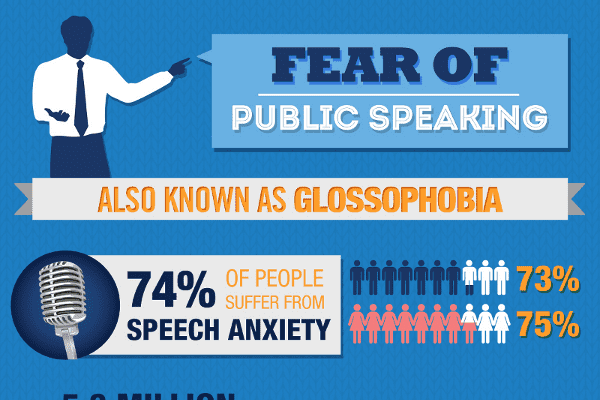Top 50 Important Public Speaking Statistics and Facts To Help You In 2025

Here are the top 50 Public speaking Statistics and Facts. Public speaking is delivering a speech or presentation to a live audience. It involves communicating ideas, information, or messages effectively to inform, persuade, entertain, or inspire listeners. Public speaking can occur in various settings, including conferences, meetings, classrooms, seminars, workshops, or any other gathering where individuals address an audience.

Critical elements of public speaking include:
- Audience Engagement: Public speakers aim to engage and captivate their audience by delivering content that is relevant, interesting, and impactful. They may use storytelling, humor, visuals, and other techniques to connect with their listeners and maintain their attention.
- Clear Communication: Effective public speaking involves conveying ideas and information clearly and concisely. Speakers use language that is accessible and understandable to their audience, avoiding jargon or technical terms that may be unfamiliar.
- Confidence and Presence: Confidence is essential for successful public speaking. Speakers project confidence through their posture, body language, tone of voice, and delivery style. They appear poised, composed, and in control, even when facing nervousness or stage fright.
- Preparation and Organization: Preparation is vital to delivering a polished and coherent speech. Public speakers research their topic thoroughly, organize their thoughts logically, and structure their presentations to flow smoothly and effectively.
- Adaptability: Public speakers must adapt to their audience’s needs and reactions. They may adjust their delivery, pace, or content based on audience feedback, questions, or unexpected circumstances.
- Persuasion and Influence: Public speaking often involves persuading or influencing the audience to accept a particular viewpoint, take action, or change their behavior. Speakers use persuasive techniques such as evidence, logic, emotion, and storytelling to make their case convincingly.
Public speaking is essential across various domains, including business, education, and the public sphere. Whether as an individual or a business entity, engaging in public speaking offers numerous advantages and benefits. Source
Overall, public speaking is a valuable skill that empowers individuals to communicate effectively, share their ideas with others, and make a positive impact in their personal and professional lives. It requires practice, preparation, and confidence, but mastering the art of public speaking can open doors to opportunities for leadership, influence, and success.

Public speaking, often hailed as one of the most feared activities for many individuals, has the unique power to inspire, inform, and captivate audiences worldwide. From boardrooms to auditoriums and classrooms to conference halls, the art of public speaking leaves an indelible mark on society.
In this article, we embark on a journey to uncover the fascinating world of public speaking through the lens of statistics. We delve into a wealth of data and insights that shed light on the prevalence, impact, and nuances of public speaking in various contexts.
From the staggering number of individuals who grapple with speech anxiety to the compelling benefits of mastering the art of persuasion, we explore the numbers that shape our understanding of public speaking today. Moreover, we uncover how public speaking influences career success, educational attainment, and personal development in the digital age.
Join us as we navigate through various statistics, anecdotes, and expert opinions to unveil the power and potential of public speaking in our society. Whether you’re a seasoned or aspiring speaker, a student, a professional, or intrigued by the art of rhetoric, this article offers valuable insights into the significance of public speaking in the modern world.
Prepare to be enlightened, inspired, and empowered as we embark on this enlightening journey into the realm of public speaking statistics.
Public Speaking Statistics
Here are 50 potential public speaking statistics to help you
- Approximately 75% of people experience some degree of glossophobia or fear of public speaking.
Glossophobia is an anxiety disorder whereby one is faced with extreme fear when it comes to talking in front of a large crowd of people. Source

- Public speaking is ranked as the number one fear among Americans, even surpassing the fear of death. Source
- Roughly 70% of employed Americans say that presentation skills are critical for career success. Source
- TED Talks, renowned for their captivating speakers, have surpassed 2 billion views collectively. Source
- On average, people remember only 25-30% of what they hear in a speech. Source
- According to a survey, 70% of people believe that presentation skills are essential for getting ahead in their careers. Source
- Nonverbal communication, such as body language and tone of voice, accounts for over 90% of the impact of a speech. Source
- The average attention span of an adult is around 8 seconds, emphasizing the importance of engaging content and delivery. Source
- Only about 1 in 10 people feel entirely comfortable speaking in front of an audience. Source
- Over 80% of job recruiters consider communication skills, including public speaking, as crucial when evaluating candidates. Source
- 75% of people report experiencing symptoms of stage fright before speaking in public. Source
- Roughly 95% of Americans believe that public speaking skills are critical for success in their personal and professional lives. Source
- An estimated 4 out of 5 people suffer from speech anxiety, making it one of the most common phobias. Source
- Studies indicate that in public speaking, communication comprises 55% of non-verbal cues, 38% of vocal elements, and merely 7% of verbal content. Source
- Nearly 75% of individuals rank speaking confidently in public as a top skill for personal growth. Source
- Public speaking skills are considered more important than technical skills by 70% of employers. Source
- Over 60% of people feel that public speaking skills are vital for building self-confidence. Source
- While captivating storytelling effectively grabs the audience’s attention, 46% of surveyed individuals identify “crafting a compelling narrative” as the most daunting aspect of preparation. Source “Developing an innovative layout” ranks second with 45%, while “locating and integrating impactful visuals” secures the third position with 41%.

- Studies suggest that individuals with strong public speaking skills earn an average of 10% more than those without. Source
- Approximately 79% of individuals perceive the majority of presentations as dull and uninteresting. This often stems from inadequate or absent visuals, extensive bullet points, and a lack of audience engagement. Source
- Roughly 95% of people say they have been impressed by a speaker who has made eye contact during a presentation. Source
- Nearly 70% of teachers believe public speaking skills are essential for academic success. Source
- Studies show that practicing public speaking can increase self-esteem and confidence by over 20%. Source
- Over 80% of college students report feeling anxiety when required to give a speech or presentation. Source
- According to a glance test conducted in 2022, you have a maximum of 3 seconds to captivate your audience’s attention for each slide you present. Source
- In public speaking, friendliness, assertiveness, and appearance are important as they often shape people’s impressions. Source
- Approximately 91% of presenters experience increased confidence when delivering a presentation with a well-designed slide deck. Source
- Approximately 90% of TED Talks speakers feel nervous before going on stage. Source
- Microsoft PowerPoint is the most commonly utilized software for public speaking and presentation creation. Reportedly, 89% of public speakers and presenters rely on this software as their primary tool for delivering presentations. Source
- The National Speakers Association (NSA) boasts a membership of approximately 2,500 to 5,000 individuals. Source
- According to Source, 60% of individuals indicate that they won’t respect a speaker who is poorly dressed. This underscores the significance of your appearance in influencing how your audience perceives you and interacts with your message.
- Roughly 85% of jobs require public speaking or presentation skills. Source
- According to Guinness World Records (GWR), Donald Trump is the highest-paid public speaker for a single event, earning $1.5 million per speech. However, Tony Blair retains the title of the highest-paid and wealthiest public speaker overall. This distinction arises because Donald Trump does not receive as many public speaking engagements as Tony Blair or other top public speakers.
- According to Source, as a public speaker, you have approximately 27 seconds to make a favorable first impression. This initial impression holds significant weight as individuals tend to gravitate toward speakers who exude confidence and present themselves in a polished manner.

- Reportedly, 86% of individuals residing in low-income communities earning less than $50,000 annually harbor a profound fear of public speaking. This fear stems from a profound sense of insecurity. Source
- According to Source, prominent causes of public speaking anxiety (PSA) among students include the fear of receiving low evaluations from teachers, apprehension stemming from past failures, and concern over negative feedback from the audience.
Additional factors contributing to PSA may encompass inadequate skills development, genetic predisposition, and feelings of embarrassment.
- Statistics indicate that 44% of women and 37% of men experience significant anxiety when addressing large crowds. This suggests that women are more prone than men to experiencing heightened anxiety during public speaking engagements. Source
- Individuals grappling with severe public speaking anxiety (PSA) frequently encounter physical manifestations such as sweaty palms, rapid heartbeats, and trembling speech. Source
- Roughly 80% of UK students concurred that oral presentations serve as the primary source of their social anxiety. Source
- Studies suggest that individuals with strong public speaking skills are more likely to be promoted to leadership positions. Source
- Findings from a conducted study revealed varying levels of public speaking anxiety among participants: 50% reported high anxiety, 42% experienced moderate anxiety, and 9% indicated low anxiety. Source
- The intensity of public speaking fear is profound enough to potentially diminish your earnings by 10% and impede your promotion to a higher position by 15%. Source
- Research indicates that individuals with strong public speaking skills earn an average of 10-15% more than those without. Source
- According to Source, 24% of surveyed college students harbored a deep fear of public speaking. Furthermore, 52% of high school graduates reported experiencing the same fear. This underscores how educational level influences people’s phobia of public speaking.
- In the USA, a combined 7.9% of individuals, inclusive of both males and females, grappled with social anxiety disorder. Source
- In the USA, a combined 7.9% of individuals, inclusive of both males and females, grappled with social anxiety disorder. Source
- Individuals commonly confront internal and external fears when engaging in public speaking.
Internal fears typically stem from the individual’s personal emotions and their anticipation of their own performance.
External fears often arise from the individual’s excessive preoccupation with their audience. Source
- According to a survey, 76% of individuals concur that a speaker with a foreign accent has the ability to captivate the audience. Source
- Individuals typically become aware of their social anxiety disorder between the ages of 8 to 15 years. Source
- In a recent survey, it was found that 64% of U.S. undergraduates acknowledge experiencing a fear of public speaking. Source
Exploring the Latest Trends in Public Speaking for 2024 and Beyond
The landscape of public speaking has continuously evolved over time and is poised for further significant changes in the future.
The journey of evolution began with speakers mesmerizing audiences solely with the power of their words, which later transitioned into the era of PowerPoint presentations.
The integration of visuals into public speaking has revolutionized audience engagement, prompting individuals to become more attentive listeners.
Presently, public speaking has transcended physical venues, with the emergence of virtual speaking gaining widespread popularity. Virtual speaking events are conducted on platforms such as Google Meet, Zoom, Skype, and other video conferencing tools.
Moreover, with an average audience attention span of eight to ten minutes, speakers are challenged to innovate and maintain audience engagement throughout their presentations. This necessitates incorporating fresh elements every few minutes to prevent audience disengagement.
In response to busy schedules, speaking durations have become shorter. Speakers are typically allotted 10 to 30 minutes to deliver their talks.
These shifts, alongside other subtle changes, have given rise to emerging trends and best practices that speakers must embrace to stay relevant and effective in the evolving landscape of public speaking.
Let’s delve deeper into these latest trends, which not only shape the future of public speaking but also offer valuable insights into overcoming the fear of public speaking.
- Enhanced Understanding of Speaker Responsibilities
In the realm of public speaking, the initial moments are critical. If you fail to engage your audience within the first few minutes, you risk losing their attention. This underscores the importance of comprehending your role as a speaker from the outset.
As a speaker, you are responsible for every aspect of a presentation, from the pre-speech preparations to the research, writing, visuals, and delivery. Additionally, anticipate and be prepared to address queries or engage in interactive dialogue with your audience.
Mental readiness is paramount in fulfilling your duties as a speaker. Your audience can discern if you’re thrown off balance during your speech, which can encourage their continued attention or lead to disengagement.
In today’s digital age, the dynamics of speech preparation differ between live and virtual presentations. Notably, approximately 67.3% of speeches are now delivered in virtual settings. Thus, it is imperative to meticulously craft your virtual speaking environment, including considerations for lighting, microphone quality, background aesthetics, and, of course, the content of your speech.
- Anticipate a Surge in In-Person Speaking Events
Despite the surge in virtual speaking events during the pandemic, in-person engagements are reclaiming their prominence quickly.
In-person public speaking offers speakers a unique opportunity to establish genuine connections and foster meaningful engagement with their audience, free from the distractions inherent in virtual settings.
While the resurgence of in-person events commenced gradually in 2022 and 2023, the trend is expected to accelerate significantly in 2024. Speakers can now relish the chance to personally interact with their audience, exchange handshakes, and indulge in casual conversations, further enhancing the rapport and impact of their presentations.
- Rise of Personal Branding
The trend of personal branding is anticipated to gain significant traction in the realm of public speaking in the foreseeable future. Personal branding entails the deliberate cultivation and communication of a distinct and authentic identity across various platforms, both online and offline.
In public speaking, personal branding holds immense potential as it enables speakers to forge deeper connections with their audience on an individualized level. Speakers can differentiate themselves from others by showcasing their unique personalities and values and establishing a compelling reputation.
As technology advances, personal branding is poised to become increasingly pivotal in public speaking. With the proliferation of social media platforms, speakers can amplify their personal brand to reach a wider audience and cultivate a dedicated following.
This heightened visibility can unlock new speaking opportunities and elevate the speaker’s status as a respected authority within their niche. Moreover, personal branding fosters an aura of authenticity and trust, crucial elements for effectively engaging with an audience in the context of public speaking.
- Niche Speaking: Embracing Specialized Topics
Niche speaking entails directing focus toward a specific subject matter rather than delivering a broad-ranging presentation. This trend is propelled by the increasing demand for personalized content and the imperative for authenticity and rapport.
By delving into niche topics, speakers can establish stronger connections with their audience, tapping into subjects they are genuinely passionate about. This tailored approach to public speaking resonates deeply with particular audiences, fostering a sense of intimacy and relevance.
Niche speaking allows for more personalized and engaging interaction, enabling speakers to forge deeper connections with their audience. This approach proves remarkably effective when the audience shares a mutual interest with the speaker, enhancing the overall impact and resonance of the presentation.
- Hybrid Presentations: Embracing the Best of Both Worlds
As in-person events regain momentum, the enduring legacy of virtual speaking events remains undeniable. The pandemic underscored the viability of virtual meetings and gatherings, offering speakers the opportunity to engage with audiences from around the globe.
Both physical and virtual events provide distinct advantages for speakers. The emergence of hybrid events—a fusion of physical and virtual elements—is poised to become increasingly prevalent.
However, the success of hybrid events hinges on effectively managing the needs of in-person and virtual audiences. Speakers often err by prioritizing the live audience, inadvertently alienating the virtual attendees.
To mitigate this disparity, it’s imperative to ensure equitable engagement with both audiences. Requesting tools that enable visibility of the virtual audience can bridge the gap, allowing speakers to gauge the virtual attendees’ reactions and tailor their presentations accordingly.
Furthermore, speakers must remain cognizant of the nuanced differences in humor and engagement between live and virtual audiences. A thoughtful approach seamlessly integrates references and interactions with both audiences throughout the presentation.
Speakers can maximize engagement and foster a cohesive, inclusive experience for all participants by conscientiously accommodating the needs of both in-person and virtual attendees.
- Workshop-style Presentations: Enhancing Audience Engagement
The significance of audience participation in public speaking events cannot be overstated, regardless of whether they are conducted virtually or in person.
Therefore, more speaking events are expected to embrace a workshop-style format.
This interactive approach facilitates full audience involvement and connection. Speakers will transition from the traditional large stage setup to being amidst the audience, providing practical demonstrations and fostering direct interaction.
This intimate setting enables the audience to have a clear view of the speaker, actively engage in the discussion, and cultivate a mutually beneficial relationship.
- Sustained Embrace of Video Content
The utilization of videos remains a timeless trend, as video content continues to reign supreme as one of the most consumable forms of media.
Videos are powerful tools for capturing and retaining audience attention. Gone are the days when audiences were satisfied with mere text or static visuals; they crave vibrant, dynamic imagery on the screen. As a public speaker, leveraging videos can enhance your presentation’s impact and engagement.
Incorporating video clips reinforces spoken messages, aiding audience retention and comprehension. To maximize effectiveness, opt for short and impactful video clips that leave a lasting impression. With just seconds to captivate your audience, prioritize concise and compelling content.
The relevance of your chosen videos is paramount. Select content that aligns closely with your message and resonates with your audience. Let each video clip serve as a succinct illustration, reinforcing key points and enhancing audience understanding.
However, while videos are valuable assets, they should complement rather than dominate your speech. Strike a balance by interspersing videos judiciously throughout your presentation, knowing when to pause, and resume speaking to maintain a personal connection with your audience.
- Embracing Community-Centric Events
In today’s landscape, community is paramount. Fostering intimacy and engagement is key to establishing a profound connection with your audience.
While addressing a vast audience was once deemed a significant achievement, the focus has shifted toward cultivating a more engaged community. Rather than striving to address thousands of individuals simultaneously, speakers are increasingly prioritizing interactions with niche audiences.
Maintaining the engagement of a smaller audience, typically comprising 250+ individuals, is more feasible and impactful than addressing larger crowds exceeding 1000 attendees.
While events with extensive audiences still exist, they have become less prevalent compared to previous years. For speakers, connecting intimately with their audience presents a chance to make a meaningful impact and garner positive feedback.
Commonly Asked Questions
- Which Occupations Require Public Speaking?
- Public speaking skills are necessary for roles in professions such as lawyers, educators, spokespersons, politicians, and advocates.
- Why is Public Speaking Significant?
- Public speaking is immensely important as it has the power to influence and inform audiences. A speaker’s words can profoundly impact listeners, either positively or negatively, making effective communication essential in various contexts.
- What Are Some Common Fears of Public Speaking?
- Common fears associated with public speaking include fear of doubt, audience reactions, forgetting speech, nervousness, and fear of the unexpected.
- Is Public Speaking More Feared Than Death?
- Indeed, public speaking is widely regarded as one of the most feared activities, often surpassing the fear of death itself. Statistics indicate that approximately 73% of individuals worldwide experience glossophobia, the fear of public speaking.
- What Are the Symptoms of Glossophobia?
- Symptoms of glossophobia include rapid heartbeat, shortness of breath or hyperventilation, trembling, nausea, vomiting, muscle tension, sweating, and dizziness.
CONCLUSION
In conclusion, these 50 crucial public speaking statistics shed light on the pervasive influence of effective communication in various spheres of life. From the prevalence of glossophobia to the impact of public speaking skills on career advancement, these statistics underscore the significance of mastering the art of public speaking. As technology evolves and speaking platforms diversify, speakers must adapt to emerging trends such as virtual speaking and personalized content delivery. With the proper preparation, mindset, and understanding of audience dynamics, individuals can harness the power of public speaking to inform, inspire, and captivate audiences worldwide.






